Social Perspectives on Population Health: The Elderly People in Australia
VerifiedAdded on 2023/06/05
|10
|2992
|314
AI Summary
This paper explores social exclusion perspectives and the related impact among the elderly people in Australia. It also discusses the health and wellbeing impacts emanating from social exclusion.
Contribute Materials
Your contribution can guide someone’s learning journey. Share your
documents today.
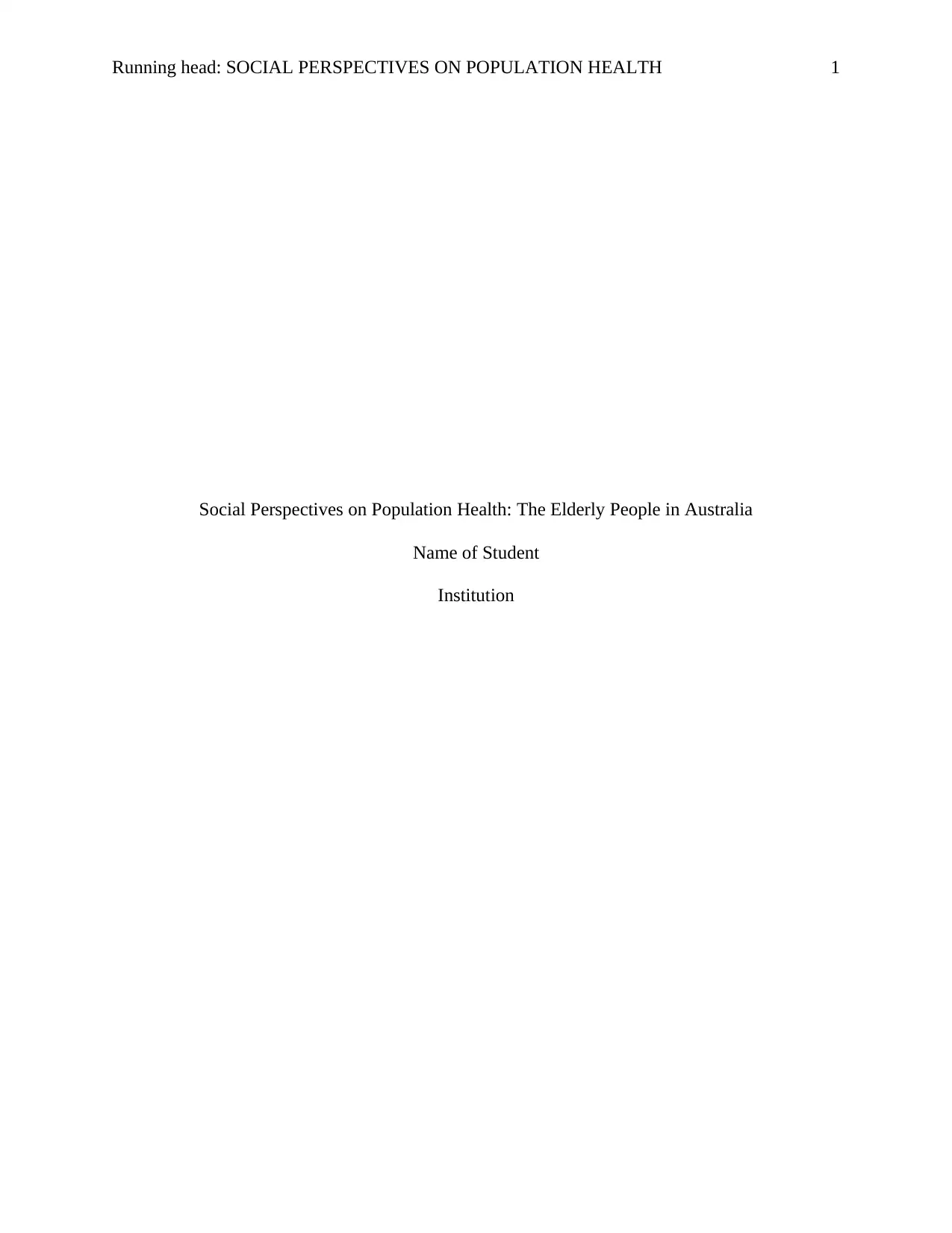
Running head: SOCIAL PERSPECTIVES ON POPULATION HEALTH 1
Social Perspectives on Population Health: The Elderly People in Australia
Name of Student
Institution
Social Perspectives on Population Health: The Elderly People in Australia
Name of Student
Institution
Secure Best Marks with AI Grader
Need help grading? Try our AI Grader for instant feedback on your assignments.
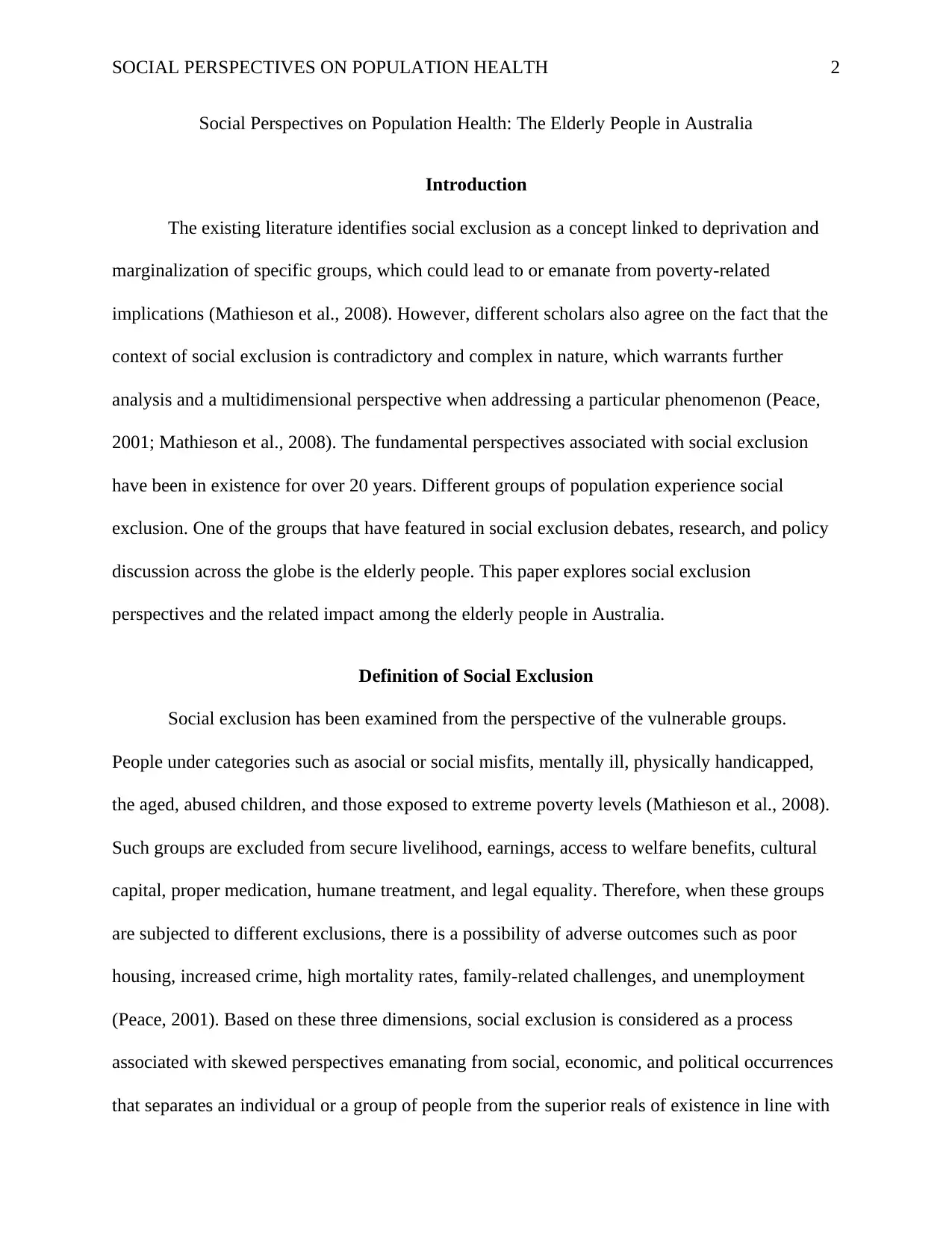
SOCIAL PERSPECTIVES ON POPULATION HEALTH 2
Social Perspectives on Population Health: The Elderly People in Australia
Introduction
The existing literature identifies social exclusion as a concept linked to deprivation and
marginalization of specific groups, which could lead to or emanate from poverty-related
implications (Mathieson et al., 2008). However, different scholars also agree on the fact that the
context of social exclusion is contradictory and complex in nature, which warrants further
analysis and a multidimensional perspective when addressing a particular phenomenon (Peace,
2001; Mathieson et al., 2008). The fundamental perspectives associated with social exclusion
have been in existence for over 20 years. Different groups of population experience social
exclusion. One of the groups that have featured in social exclusion debates, research, and policy
discussion across the globe is the elderly people. This paper explores social exclusion
perspectives and the related impact among the elderly people in Australia.
Definition of Social Exclusion
Social exclusion has been examined from the perspective of the vulnerable groups.
People under categories such as asocial or social misfits, mentally ill, physically handicapped,
the aged, abused children, and those exposed to extreme poverty levels (Mathieson et al., 2008).
Such groups are excluded from secure livelihood, earnings, access to welfare benefits, cultural
capital, proper medication, humane treatment, and legal equality. Therefore, when these groups
are subjected to different exclusions, there is a possibility of adverse outcomes such as poor
housing, increased crime, high mortality rates, family-related challenges, and unemployment
(Peace, 2001). Based on these three dimensions, social exclusion is considered as a process
associated with skewed perspectives emanating from social, economic, and political occurrences
that separates an individual or a group of people from the superior reals of existence in line with
Social Perspectives on Population Health: The Elderly People in Australia
Introduction
The existing literature identifies social exclusion as a concept linked to deprivation and
marginalization of specific groups, which could lead to or emanate from poverty-related
implications (Mathieson et al., 2008). However, different scholars also agree on the fact that the
context of social exclusion is contradictory and complex in nature, which warrants further
analysis and a multidimensional perspective when addressing a particular phenomenon (Peace,
2001; Mathieson et al., 2008). The fundamental perspectives associated with social exclusion
have been in existence for over 20 years. Different groups of population experience social
exclusion. One of the groups that have featured in social exclusion debates, research, and policy
discussion across the globe is the elderly people. This paper explores social exclusion
perspectives and the related impact among the elderly people in Australia.
Definition of Social Exclusion
Social exclusion has been examined from the perspective of the vulnerable groups.
People under categories such as asocial or social misfits, mentally ill, physically handicapped,
the aged, abused children, and those exposed to extreme poverty levels (Mathieson et al., 2008).
Such groups are excluded from secure livelihood, earnings, access to welfare benefits, cultural
capital, proper medication, humane treatment, and legal equality. Therefore, when these groups
are subjected to different exclusions, there is a possibility of adverse outcomes such as poor
housing, increased crime, high mortality rates, family-related challenges, and unemployment
(Peace, 2001). Based on these three dimensions, social exclusion is considered as a process
associated with skewed perspectives emanating from social, economic, and political occurrences
that separates an individual or a group of people from the superior reals of existence in line with
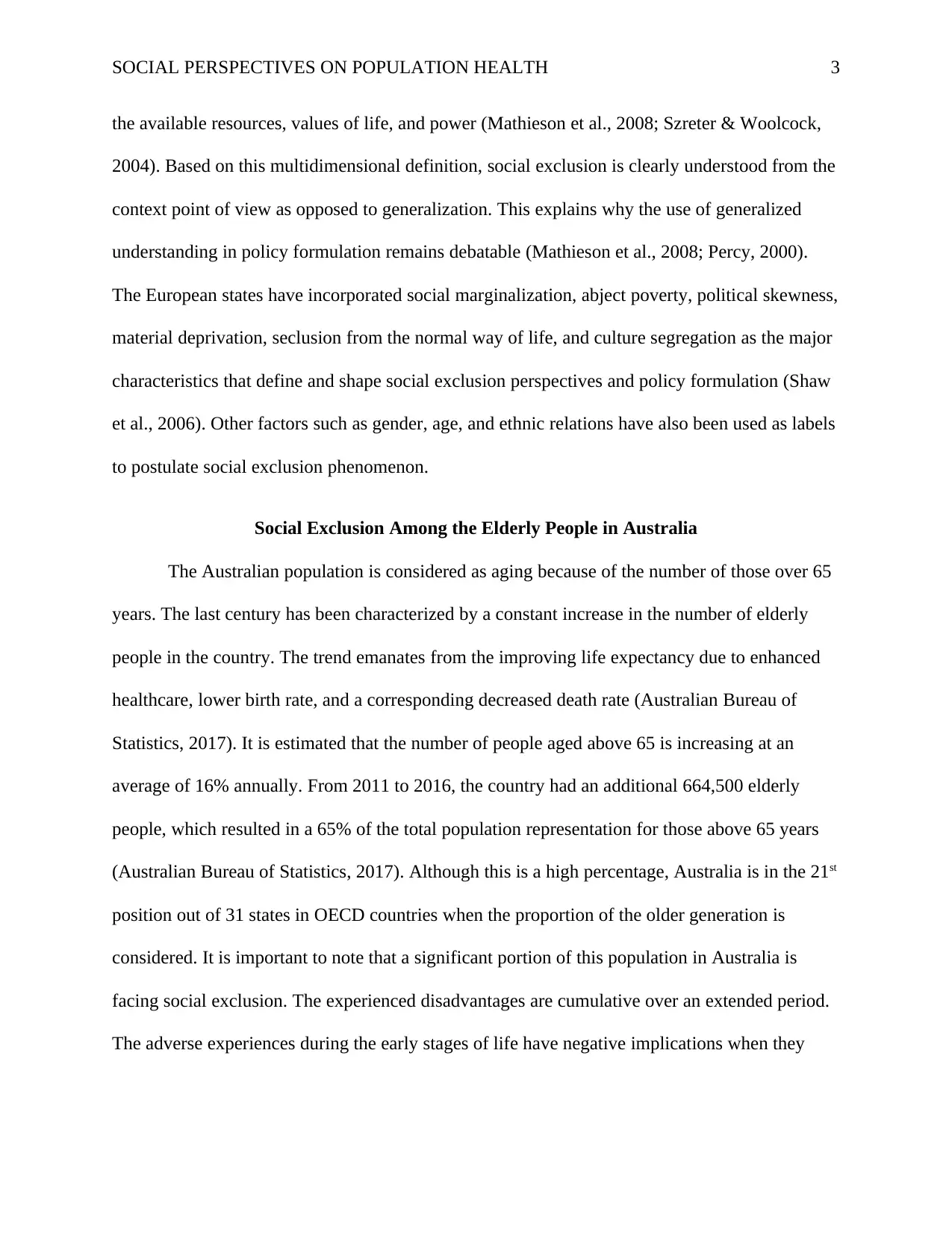
SOCIAL PERSPECTIVES ON POPULATION HEALTH 3
the available resources, values of life, and power (Mathieson et al., 2008; Szreter & Woolcock,
2004). Based on this multidimensional definition, social exclusion is clearly understood from the
context point of view as opposed to generalization. This explains why the use of generalized
understanding in policy formulation remains debatable (Mathieson et al., 2008; Percy, 2000).
The European states have incorporated social marginalization, abject poverty, political skewness,
material deprivation, seclusion from the normal way of life, and culture segregation as the major
characteristics that define and shape social exclusion perspectives and policy formulation (Shaw
et al., 2006). Other factors such as gender, age, and ethnic relations have also been used as labels
to postulate social exclusion phenomenon.
Social Exclusion Among the Elderly People in Australia
The Australian population is considered as aging because of the number of those over 65
years. The last century has been characterized by a constant increase in the number of elderly
people in the country. The trend emanates from the improving life expectancy due to enhanced
healthcare, lower birth rate, and a corresponding decreased death rate (Australian Bureau of
Statistics, 2017). It is estimated that the number of people aged above 65 is increasing at an
average of 16% annually. From 2011 to 2016, the country had an additional 664,500 elderly
people, which resulted in a 65% of the total population representation for those above 65 years
(Australian Bureau of Statistics, 2017). Although this is a high percentage, Australia is in the 21st
position out of 31 states in OECD countries when the proportion of the older generation is
considered. It is important to note that a significant portion of this population in Australia is
facing social exclusion. The experienced disadvantages are cumulative over an extended period.
The adverse experiences during the early stages of life have negative implications when they
the available resources, values of life, and power (Mathieson et al., 2008; Szreter & Woolcock,
2004). Based on this multidimensional definition, social exclusion is clearly understood from the
context point of view as opposed to generalization. This explains why the use of generalized
understanding in policy formulation remains debatable (Mathieson et al., 2008; Percy, 2000).
The European states have incorporated social marginalization, abject poverty, political skewness,
material deprivation, seclusion from the normal way of life, and culture segregation as the major
characteristics that define and shape social exclusion perspectives and policy formulation (Shaw
et al., 2006). Other factors such as gender, age, and ethnic relations have also been used as labels
to postulate social exclusion phenomenon.
Social Exclusion Among the Elderly People in Australia
The Australian population is considered as aging because of the number of those over 65
years. The last century has been characterized by a constant increase in the number of elderly
people in the country. The trend emanates from the improving life expectancy due to enhanced
healthcare, lower birth rate, and a corresponding decreased death rate (Australian Bureau of
Statistics, 2017). It is estimated that the number of people aged above 65 is increasing at an
average of 16% annually. From 2011 to 2016, the country had an additional 664,500 elderly
people, which resulted in a 65% of the total population representation for those above 65 years
(Australian Bureau of Statistics, 2017). Although this is a high percentage, Australia is in the 21st
position out of 31 states in OECD countries when the proportion of the older generation is
considered. It is important to note that a significant portion of this population in Australia is
facing social exclusion. The experienced disadvantages are cumulative over an extended period.
The adverse experiences during the early stages of life have negative implications when they
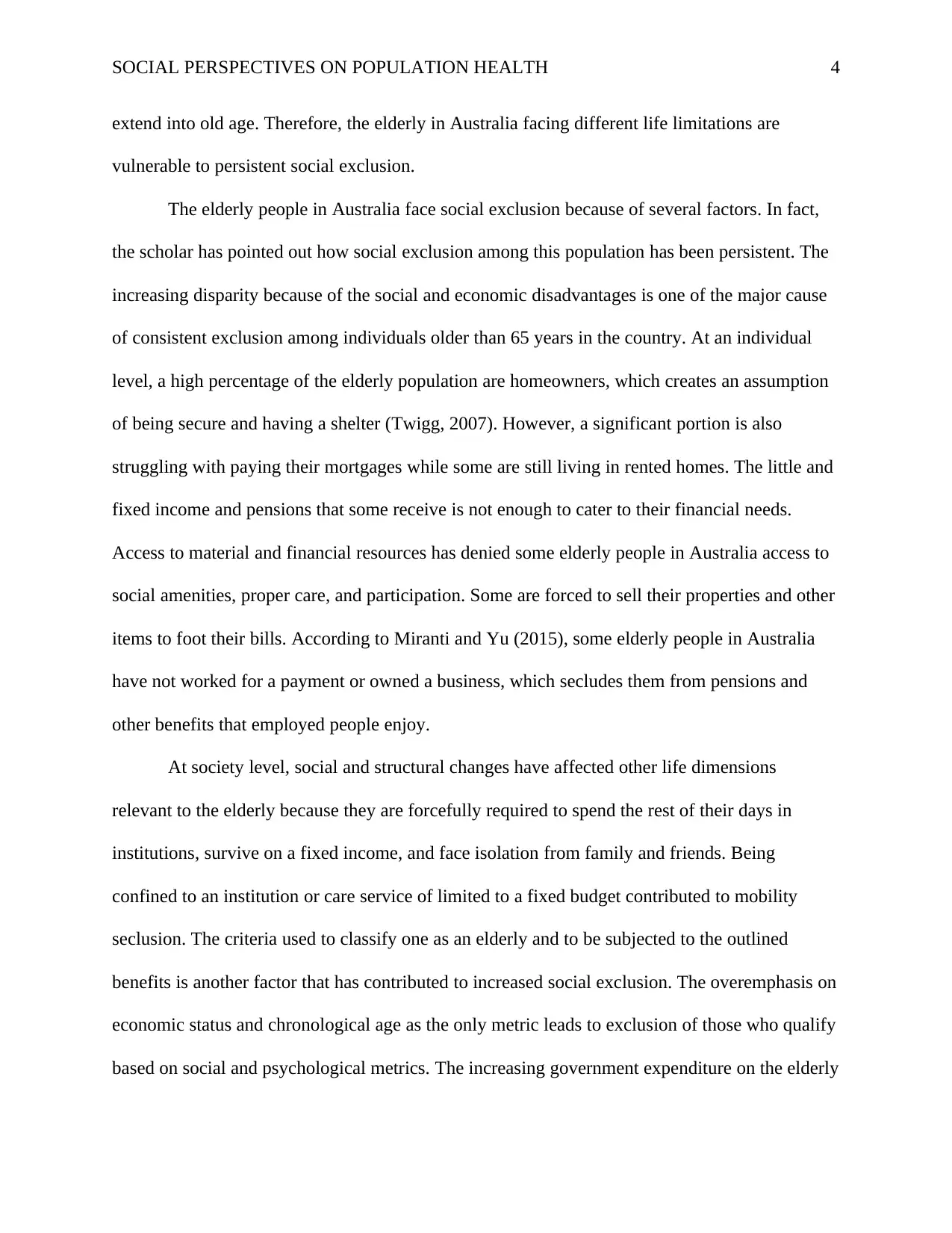
SOCIAL PERSPECTIVES ON POPULATION HEALTH 4
extend into old age. Therefore, the elderly in Australia facing different life limitations are
vulnerable to persistent social exclusion.
The elderly people in Australia face social exclusion because of several factors. In fact,
the scholar has pointed out how social exclusion among this population has been persistent. The
increasing disparity because of the social and economic disadvantages is one of the major cause
of consistent exclusion among individuals older than 65 years in the country. At an individual
level, a high percentage of the elderly population are homeowners, which creates an assumption
of being secure and having a shelter (Twigg, 2007). However, a significant portion is also
struggling with paying their mortgages while some are still living in rented homes. The little and
fixed income and pensions that some receive is not enough to cater to their financial needs.
Access to material and financial resources has denied some elderly people in Australia access to
social amenities, proper care, and participation. Some are forced to sell their properties and other
items to foot their bills. According to Miranti and Yu (2015), some elderly people in Australia
have not worked for a payment or owned a business, which secludes them from pensions and
other benefits that employed people enjoy.
At society level, social and structural changes have affected other life dimensions
relevant to the elderly because they are forcefully required to spend the rest of their days in
institutions, survive on a fixed income, and face isolation from family and friends. Being
confined to an institution or care service of limited to a fixed budget contributed to mobility
seclusion. The criteria used to classify one as an elderly and to be subjected to the outlined
benefits is another factor that has contributed to increased social exclusion. The overemphasis on
economic status and chronological age as the only metric leads to exclusion of those who qualify
based on social and psychological metrics. The increasing government expenditure on the elderly
extend into old age. Therefore, the elderly in Australia facing different life limitations are
vulnerable to persistent social exclusion.
The elderly people in Australia face social exclusion because of several factors. In fact,
the scholar has pointed out how social exclusion among this population has been persistent. The
increasing disparity because of the social and economic disadvantages is one of the major cause
of consistent exclusion among individuals older than 65 years in the country. At an individual
level, a high percentage of the elderly population are homeowners, which creates an assumption
of being secure and having a shelter (Twigg, 2007). However, a significant portion is also
struggling with paying their mortgages while some are still living in rented homes. The little and
fixed income and pensions that some receive is not enough to cater to their financial needs.
Access to material and financial resources has denied some elderly people in Australia access to
social amenities, proper care, and participation. Some are forced to sell their properties and other
items to foot their bills. According to Miranti and Yu (2015), some elderly people in Australia
have not worked for a payment or owned a business, which secludes them from pensions and
other benefits that employed people enjoy.
At society level, social and structural changes have affected other life dimensions
relevant to the elderly because they are forcefully required to spend the rest of their days in
institutions, survive on a fixed income, and face isolation from family and friends. Being
confined to an institution or care service of limited to a fixed budget contributed to mobility
seclusion. The criteria used to classify one as an elderly and to be subjected to the outlined
benefits is another factor that has contributed to increased social exclusion. The overemphasis on
economic status and chronological age as the only metric leads to exclusion of those who qualify
based on social and psychological metrics. The increasing government expenditure on the elderly
Secure Best Marks with AI Grader
Need help grading? Try our AI Grader for instant feedback on your assignments.
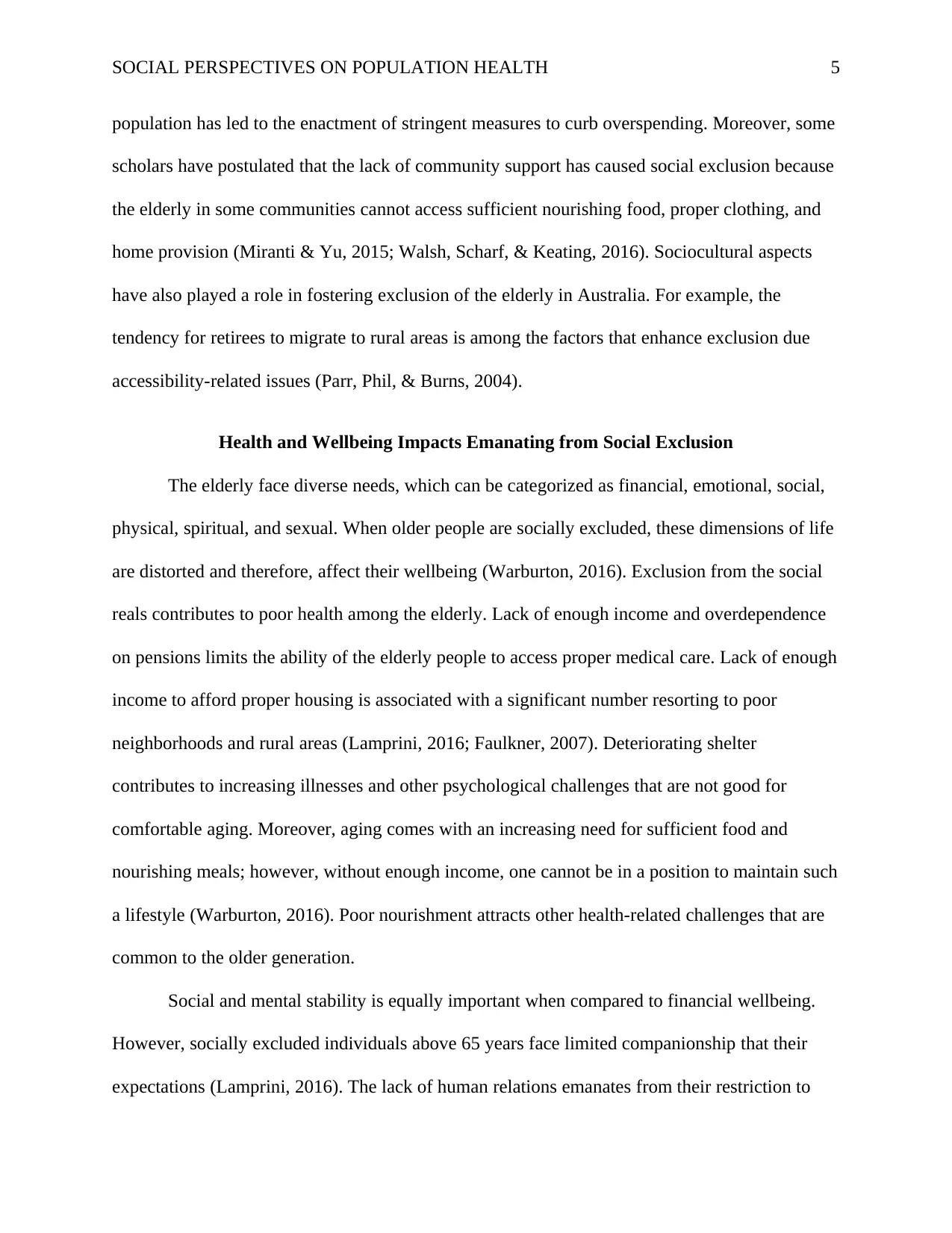
SOCIAL PERSPECTIVES ON POPULATION HEALTH 5
population has led to the enactment of stringent measures to curb overspending. Moreover, some
scholars have postulated that the lack of community support has caused social exclusion because
the elderly in some communities cannot access sufficient nourishing food, proper clothing, and
home provision (Miranti & Yu, 2015; Walsh, Scharf, & Keating, 2016). Sociocultural aspects
have also played a role in fostering exclusion of the elderly in Australia. For example, the
tendency for retirees to migrate to rural areas is among the factors that enhance exclusion due
accessibility-related issues (Parr, Phil, & Burns, 2004).
Health and Wellbeing Impacts Emanating from Social Exclusion
The elderly face diverse needs, which can be categorized as financial, emotional, social,
physical, spiritual, and sexual. When older people are socially excluded, these dimensions of life
are distorted and therefore, affect their wellbeing (Warburton, 2016). Exclusion from the social
reals contributes to poor health among the elderly. Lack of enough income and overdependence
on pensions limits the ability of the elderly people to access proper medical care. Lack of enough
income to afford proper housing is associated with a significant number resorting to poor
neighborhoods and rural areas (Lamprini, 2016; Faulkner, 2007). Deteriorating shelter
contributes to increasing illnesses and other psychological challenges that are not good for
comfortable aging. Moreover, aging comes with an increasing need for sufficient food and
nourishing meals; however, without enough income, one cannot be in a position to maintain such
a lifestyle (Warburton, 2016). Poor nourishment attracts other health-related challenges that are
common to the older generation.
Social and mental stability is equally important when compared to financial wellbeing.
However, socially excluded individuals above 65 years face limited companionship that their
expectations (Lamprini, 2016). The lack of human relations emanates from their restriction to
population has led to the enactment of stringent measures to curb overspending. Moreover, some
scholars have postulated that the lack of community support has caused social exclusion because
the elderly in some communities cannot access sufficient nourishing food, proper clothing, and
home provision (Miranti & Yu, 2015; Walsh, Scharf, & Keating, 2016). Sociocultural aspects
have also played a role in fostering exclusion of the elderly in Australia. For example, the
tendency for retirees to migrate to rural areas is among the factors that enhance exclusion due
accessibility-related issues (Parr, Phil, & Burns, 2004).
Health and Wellbeing Impacts Emanating from Social Exclusion
The elderly face diverse needs, which can be categorized as financial, emotional, social,
physical, spiritual, and sexual. When older people are socially excluded, these dimensions of life
are distorted and therefore, affect their wellbeing (Warburton, 2016). Exclusion from the social
reals contributes to poor health among the elderly. Lack of enough income and overdependence
on pensions limits the ability of the elderly people to access proper medical care. Lack of enough
income to afford proper housing is associated with a significant number resorting to poor
neighborhoods and rural areas (Lamprini, 2016; Faulkner, 2007). Deteriorating shelter
contributes to increasing illnesses and other psychological challenges that are not good for
comfortable aging. Moreover, aging comes with an increasing need for sufficient food and
nourishing meals; however, without enough income, one cannot be in a position to maintain such
a lifestyle (Warburton, 2016). Poor nourishment attracts other health-related challenges that are
common to the older generation.
Social and mental stability is equally important when compared to financial wellbeing.
However, socially excluded individuals above 65 years face limited companionship that their
expectations (Lamprini, 2016). The lack of human relations emanates from their restriction to
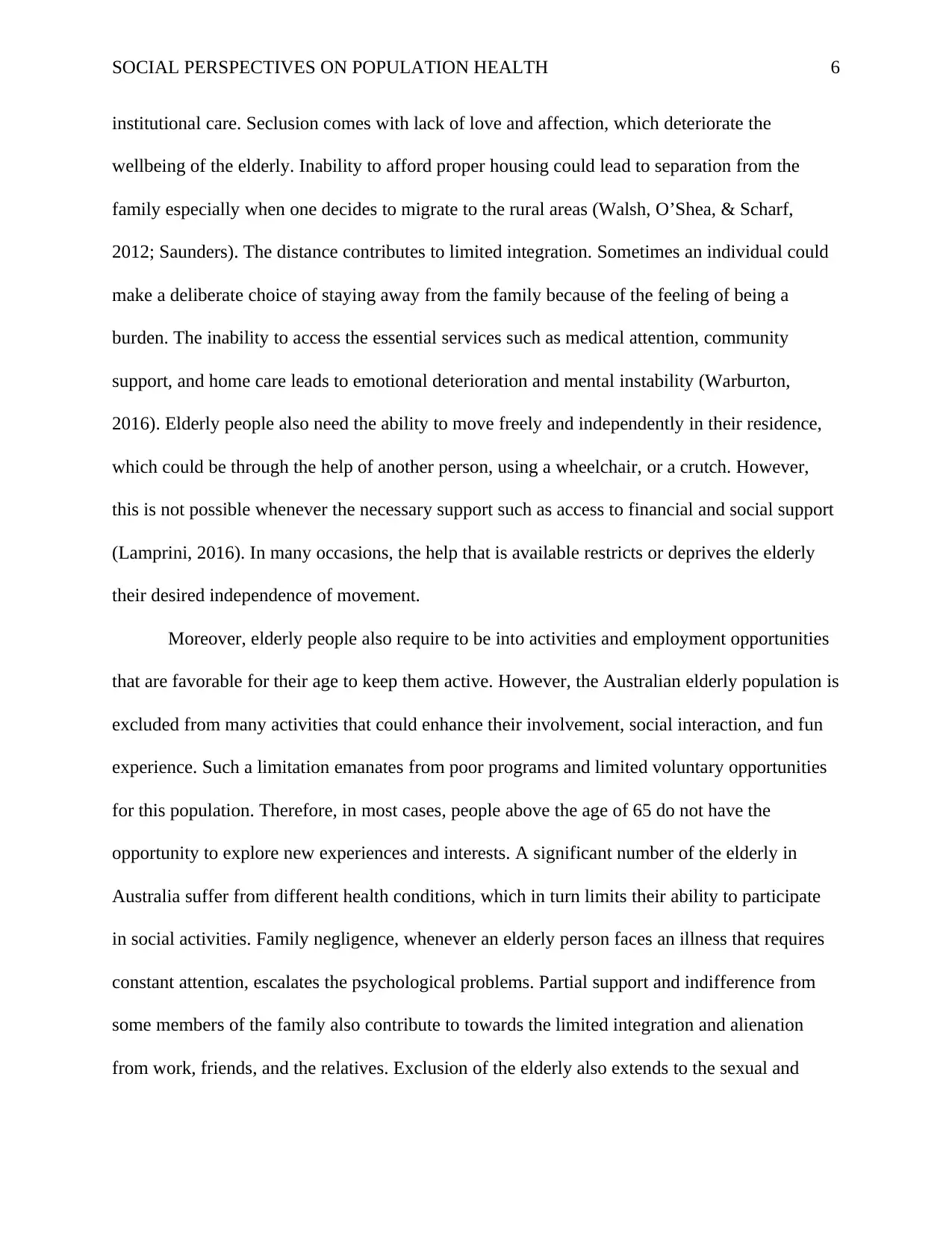
SOCIAL PERSPECTIVES ON POPULATION HEALTH 6
institutional care. Seclusion comes with lack of love and affection, which deteriorate the
wellbeing of the elderly. Inability to afford proper housing could lead to separation from the
family especially when one decides to migrate to the rural areas (Walsh, O’Shea, & Scharf,
2012; Saunders). The distance contributes to limited integration. Sometimes an individual could
make a deliberate choice of staying away from the family because of the feeling of being a
burden. The inability to access the essential services such as medical attention, community
support, and home care leads to emotional deterioration and mental instability (Warburton,
2016). Elderly people also need the ability to move freely and independently in their residence,
which could be through the help of another person, using a wheelchair, or a crutch. However,
this is not possible whenever the necessary support such as access to financial and social support
(Lamprini, 2016). In many occasions, the help that is available restricts or deprives the elderly
their desired independence of movement.
Moreover, elderly people also require to be into activities and employment opportunities
that are favorable for their age to keep them active. However, the Australian elderly population is
excluded from many activities that could enhance their involvement, social interaction, and fun
experience. Such a limitation emanates from poor programs and limited voluntary opportunities
for this population. Therefore, in most cases, people above the age of 65 do not have the
opportunity to explore new experiences and interests. A significant number of the elderly in
Australia suffer from different health conditions, which in turn limits their ability to participate
in social activities. Family negligence, whenever an elderly person faces an illness that requires
constant attention, escalates the psychological problems. Partial support and indifference from
some members of the family also contribute to towards the limited integration and alienation
from work, friends, and the relatives. Exclusion of the elderly also extends to the sexual and
institutional care. Seclusion comes with lack of love and affection, which deteriorate the
wellbeing of the elderly. Inability to afford proper housing could lead to separation from the
family especially when one decides to migrate to the rural areas (Walsh, O’Shea, & Scharf,
2012; Saunders). The distance contributes to limited integration. Sometimes an individual could
make a deliberate choice of staying away from the family because of the feeling of being a
burden. The inability to access the essential services such as medical attention, community
support, and home care leads to emotional deterioration and mental instability (Warburton,
2016). Elderly people also need the ability to move freely and independently in their residence,
which could be through the help of another person, using a wheelchair, or a crutch. However,
this is not possible whenever the necessary support such as access to financial and social support
(Lamprini, 2016). In many occasions, the help that is available restricts or deprives the elderly
their desired independence of movement.
Moreover, elderly people also require to be into activities and employment opportunities
that are favorable for their age to keep them active. However, the Australian elderly population is
excluded from many activities that could enhance their involvement, social interaction, and fun
experience. Such a limitation emanates from poor programs and limited voluntary opportunities
for this population. Therefore, in most cases, people above the age of 65 do not have the
opportunity to explore new experiences and interests. A significant number of the elderly in
Australia suffer from different health conditions, which in turn limits their ability to participate
in social activities. Family negligence, whenever an elderly person faces an illness that requires
constant attention, escalates the psychological problems. Partial support and indifference from
some members of the family also contribute to towards the limited integration and alienation
from work, friends, and the relatives. Exclusion of the elderly also extends to the sexual and
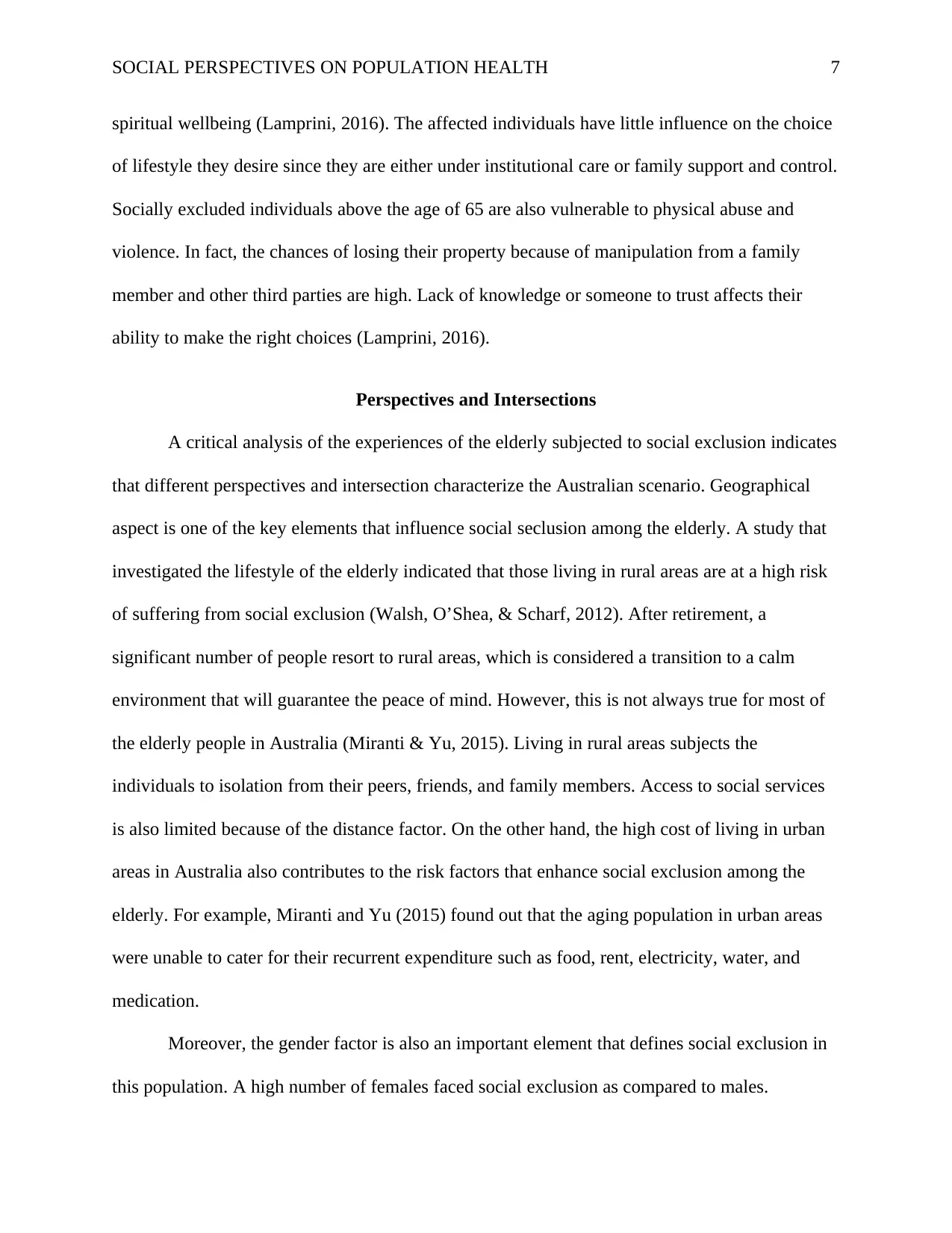
SOCIAL PERSPECTIVES ON POPULATION HEALTH 7
spiritual wellbeing (Lamprini, 2016). The affected individuals have little influence on the choice
of lifestyle they desire since they are either under institutional care or family support and control.
Socially excluded individuals above the age of 65 are also vulnerable to physical abuse and
violence. In fact, the chances of losing their property because of manipulation from a family
member and other third parties are high. Lack of knowledge or someone to trust affects their
ability to make the right choices (Lamprini, 2016).
Perspectives and Intersections
A critical analysis of the experiences of the elderly subjected to social exclusion indicates
that different perspectives and intersection characterize the Australian scenario. Geographical
aspect is one of the key elements that influence social seclusion among the elderly. A study that
investigated the lifestyle of the elderly indicated that those living in rural areas are at a high risk
of suffering from social exclusion (Walsh, O’Shea, & Scharf, 2012). After retirement, a
significant number of people resort to rural areas, which is considered a transition to a calm
environment that will guarantee the peace of mind. However, this is not always true for most of
the elderly people in Australia (Miranti & Yu, 2015). Living in rural areas subjects the
individuals to isolation from their peers, friends, and family members. Access to social services
is also limited because of the distance factor. On the other hand, the high cost of living in urban
areas in Australia also contributes to the risk factors that enhance social exclusion among the
elderly. For example, Miranti and Yu (2015) found out that the aging population in urban areas
were unable to cater for their recurrent expenditure such as food, rent, electricity, water, and
medication.
Moreover, the gender factor is also an important element that defines social exclusion in
this population. A high number of females faced social exclusion as compared to males.
spiritual wellbeing (Lamprini, 2016). The affected individuals have little influence on the choice
of lifestyle they desire since they are either under institutional care or family support and control.
Socially excluded individuals above the age of 65 are also vulnerable to physical abuse and
violence. In fact, the chances of losing their property because of manipulation from a family
member and other third parties are high. Lack of knowledge or someone to trust affects their
ability to make the right choices (Lamprini, 2016).
Perspectives and Intersections
A critical analysis of the experiences of the elderly subjected to social exclusion indicates
that different perspectives and intersection characterize the Australian scenario. Geographical
aspect is one of the key elements that influence social seclusion among the elderly. A study that
investigated the lifestyle of the elderly indicated that those living in rural areas are at a high risk
of suffering from social exclusion (Walsh, O’Shea, & Scharf, 2012). After retirement, a
significant number of people resort to rural areas, which is considered a transition to a calm
environment that will guarantee the peace of mind. However, this is not always true for most of
the elderly people in Australia (Miranti & Yu, 2015). Living in rural areas subjects the
individuals to isolation from their peers, friends, and family members. Access to social services
is also limited because of the distance factor. On the other hand, the high cost of living in urban
areas in Australia also contributes to the risk factors that enhance social exclusion among the
elderly. For example, Miranti and Yu (2015) found out that the aging population in urban areas
were unable to cater for their recurrent expenditure such as food, rent, electricity, water, and
medication.
Moreover, the gender factor is also an important element that defines social exclusion in
this population. A high number of females faced social exclusion as compared to males.
Paraphrase This Document
Need a fresh take? Get an instant paraphrase of this document with our AI Paraphraser
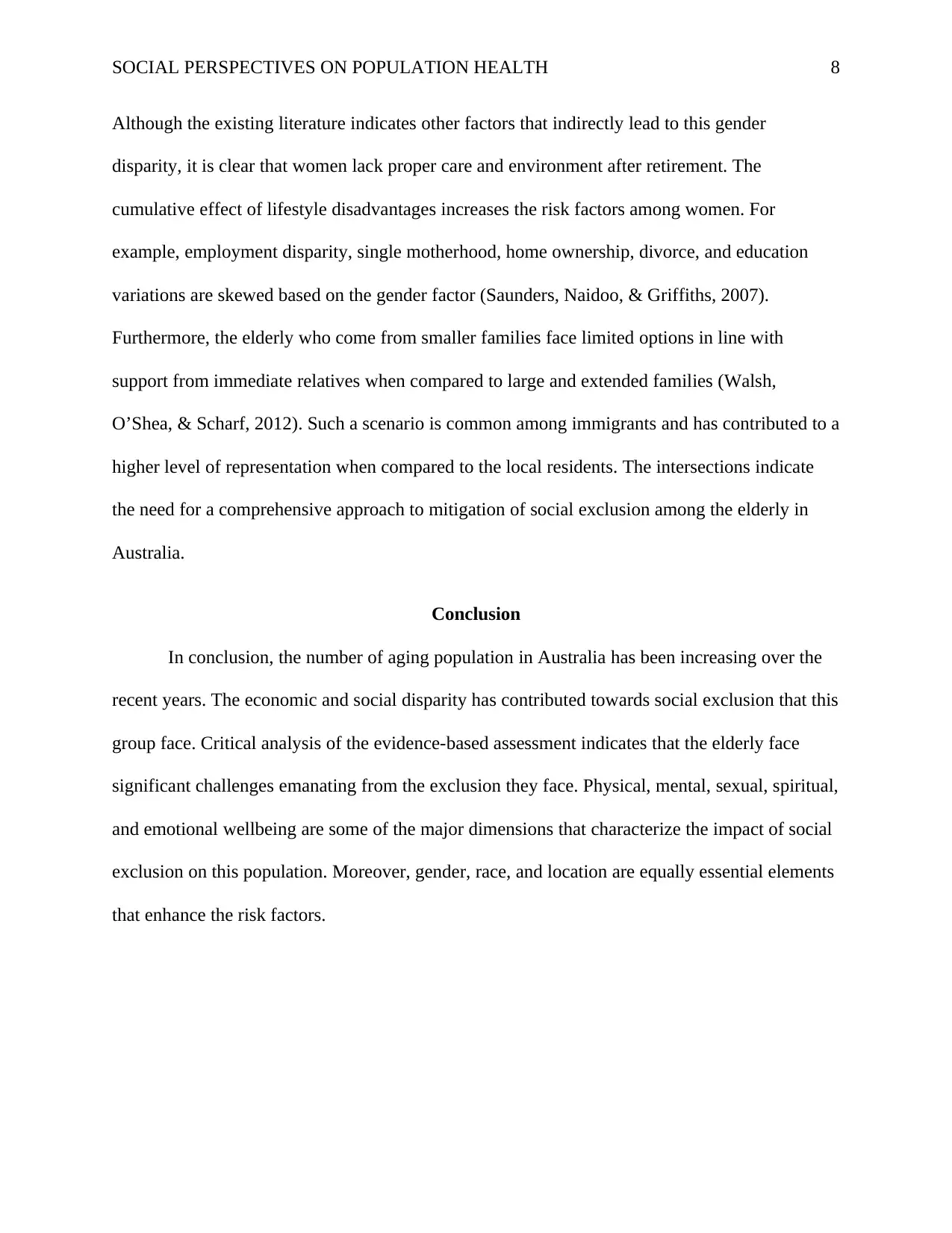
SOCIAL PERSPECTIVES ON POPULATION HEALTH 8
Although the existing literature indicates other factors that indirectly lead to this gender
disparity, it is clear that women lack proper care and environment after retirement. The
cumulative effect of lifestyle disadvantages increases the risk factors among women. For
example, employment disparity, single motherhood, home ownership, divorce, and education
variations are skewed based on the gender factor (Saunders, Naidoo, & Griffiths, 2007).
Furthermore, the elderly who come from smaller families face limited options in line with
support from immediate relatives when compared to large and extended families (Walsh,
O’Shea, & Scharf, 2012). Such a scenario is common among immigrants and has contributed to a
higher level of representation when compared to the local residents. The intersections indicate
the need for a comprehensive approach to mitigation of social exclusion among the elderly in
Australia.
Conclusion
In conclusion, the number of aging population in Australia has been increasing over the
recent years. The economic and social disparity has contributed towards social exclusion that this
group face. Critical analysis of the evidence-based assessment indicates that the elderly face
significant challenges emanating from the exclusion they face. Physical, mental, sexual, spiritual,
and emotional wellbeing are some of the major dimensions that characterize the impact of social
exclusion on this population. Moreover, gender, race, and location are equally essential elements
that enhance the risk factors.
Although the existing literature indicates other factors that indirectly lead to this gender
disparity, it is clear that women lack proper care and environment after retirement. The
cumulative effect of lifestyle disadvantages increases the risk factors among women. For
example, employment disparity, single motherhood, home ownership, divorce, and education
variations are skewed based on the gender factor (Saunders, Naidoo, & Griffiths, 2007).
Furthermore, the elderly who come from smaller families face limited options in line with
support from immediate relatives when compared to large and extended families (Walsh,
O’Shea, & Scharf, 2012). Such a scenario is common among immigrants and has contributed to a
higher level of representation when compared to the local residents. The intersections indicate
the need for a comprehensive approach to mitigation of social exclusion among the elderly in
Australia.
Conclusion
In conclusion, the number of aging population in Australia has been increasing over the
recent years. The economic and social disparity has contributed towards social exclusion that this
group face. Critical analysis of the evidence-based assessment indicates that the elderly face
significant challenges emanating from the exclusion they face. Physical, mental, sexual, spiritual,
and emotional wellbeing are some of the major dimensions that characterize the impact of social
exclusion on this population. Moreover, gender, race, and location are equally essential elements
that enhance the risk factors.
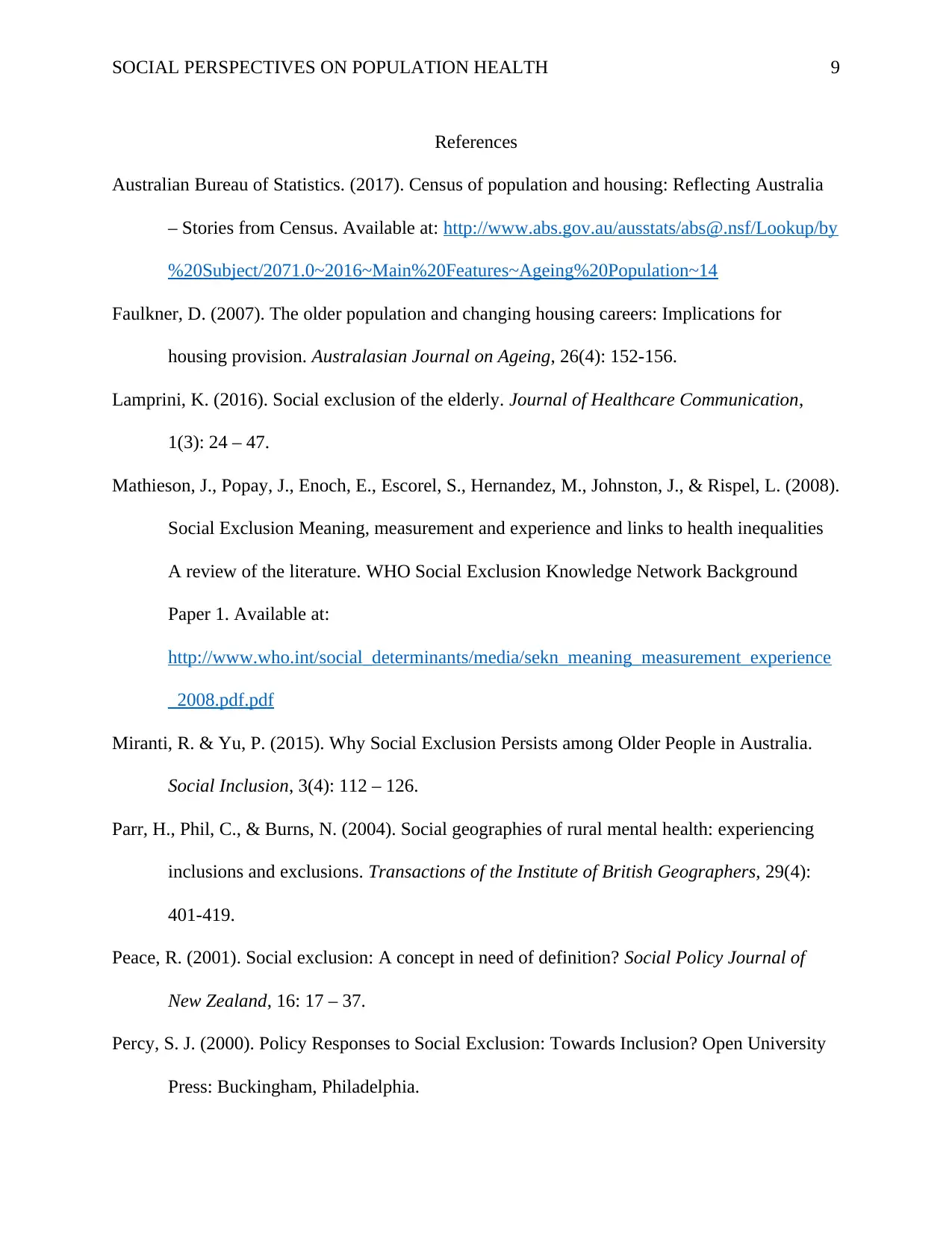
SOCIAL PERSPECTIVES ON POPULATION HEALTH 9
References
Australian Bureau of Statistics. (2017). Census of population and housing: Reflecting Australia
– Stories from Census. Available at: http://www.abs.gov.au/ausstats/abs@.nsf/Lookup/by
%20Subject/2071.0~2016~Main%20Features~Ageing%20Population~14
Faulkner, D. (2007). The older population and changing housing careers: Implications for
housing provision. Australasian Journal on Ageing, 26(4): 152-156.
Lamprini, K. (2016). Social exclusion of the elderly. Journal of Healthcare Communication,
1(3): 24 – 47.
Mathieson, J., Popay, J., Enoch, E., Escorel, S., Hernandez, M., Johnston, J., & Rispel, L. (2008).
Social Exclusion Meaning, measurement and experience and links to health inequalities
A review of the literature. WHO Social Exclusion Knowledge Network Background
Paper 1. Available at:
http://www.who.int/social_determinants/media/sekn_meaning_measurement_experience
_2008.pdf.pdf
Miranti, R. & Yu, P. (2015). Why Social Exclusion Persists among Older People in Australia.
Social Inclusion, 3(4): 112 – 126.
Parr, H., Phil, C., & Burns, N. (2004). Social geographies of rural mental health: experiencing
inclusions and exclusions. Transactions of the Institute of British Geographers, 29(4):
401-419.
Peace, R. (2001). Social exclusion: A concept in need of definition? Social Policy Journal of
New Zealand, 16: 17 – 37.
Percy, S. J. (2000). Policy Responses to Social Exclusion: Towards Inclusion? Open University
Press: Buckingham, Philadelphia.
References
Australian Bureau of Statistics. (2017). Census of population and housing: Reflecting Australia
– Stories from Census. Available at: http://www.abs.gov.au/ausstats/abs@.nsf/Lookup/by
%20Subject/2071.0~2016~Main%20Features~Ageing%20Population~14
Faulkner, D. (2007). The older population and changing housing careers: Implications for
housing provision. Australasian Journal on Ageing, 26(4): 152-156.
Lamprini, K. (2016). Social exclusion of the elderly. Journal of Healthcare Communication,
1(3): 24 – 47.
Mathieson, J., Popay, J., Enoch, E., Escorel, S., Hernandez, M., Johnston, J., & Rispel, L. (2008).
Social Exclusion Meaning, measurement and experience and links to health inequalities
A review of the literature. WHO Social Exclusion Knowledge Network Background
Paper 1. Available at:
http://www.who.int/social_determinants/media/sekn_meaning_measurement_experience
_2008.pdf.pdf
Miranti, R. & Yu, P. (2015). Why Social Exclusion Persists among Older People in Australia.
Social Inclusion, 3(4): 112 – 126.
Parr, H., Phil, C., & Burns, N. (2004). Social geographies of rural mental health: experiencing
inclusions and exclusions. Transactions of the Institute of British Geographers, 29(4):
401-419.
Peace, R. (2001). Social exclusion: A concept in need of definition? Social Policy Journal of
New Zealand, 16: 17 – 37.
Percy, S. J. (2000). Policy Responses to Social Exclusion: Towards Inclusion? Open University
Press: Buckingham, Philadelphia.
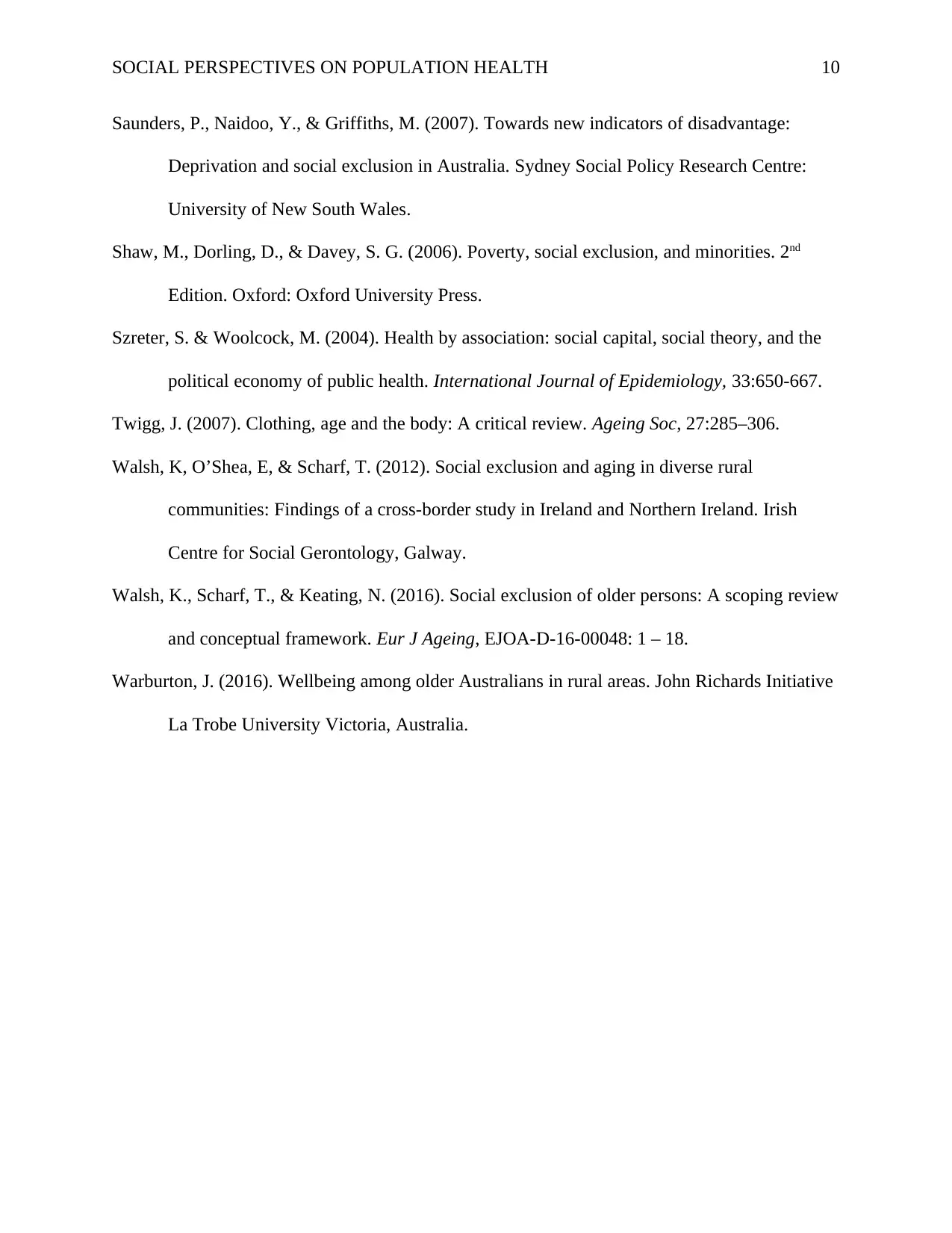
SOCIAL PERSPECTIVES ON POPULATION HEALTH 10
Saunders, P., Naidoo, Y., & Griffiths, M. (2007). Towards new indicators of disadvantage:
Deprivation and social exclusion in Australia. Sydney Social Policy Research Centre:
University of New South Wales.
Shaw, M., Dorling, D., & Davey, S. G. (2006). Poverty, social exclusion, and minorities. 2nd
Edition. Oxford: Oxford University Press.
Szreter, S. & Woolcock, M. (2004). Health by association: social capital, social theory, and the
political economy of public health. International Journal of Epidemiology, 33:650-667.
Twigg, J. (2007). Clothing, age and the body: A critical review. Ageing Soc, 27:285–306.
Walsh, K, O’Shea, E, & Scharf, T. (2012). Social exclusion and aging in diverse rural
communities: Findings of a cross-border study in Ireland and Northern Ireland. Irish
Centre for Social Gerontology, Galway.
Walsh, K., Scharf, T., & Keating, N. (2016). Social exclusion of older persons: A scoping review
and conceptual framework. Eur J Ageing, EJOA-D-16-00048: 1 – 18.
Warburton, J. (2016). Wellbeing among older Australians in rural areas. John Richards Initiative
La Trobe University Victoria, Australia.
Saunders, P., Naidoo, Y., & Griffiths, M. (2007). Towards new indicators of disadvantage:
Deprivation and social exclusion in Australia. Sydney Social Policy Research Centre:
University of New South Wales.
Shaw, M., Dorling, D., & Davey, S. G. (2006). Poverty, social exclusion, and minorities. 2nd
Edition. Oxford: Oxford University Press.
Szreter, S. & Woolcock, M. (2004). Health by association: social capital, social theory, and the
political economy of public health. International Journal of Epidemiology, 33:650-667.
Twigg, J. (2007). Clothing, age and the body: A critical review. Ageing Soc, 27:285–306.
Walsh, K, O’Shea, E, & Scharf, T. (2012). Social exclusion and aging in diverse rural
communities: Findings of a cross-border study in Ireland and Northern Ireland. Irish
Centre for Social Gerontology, Galway.
Walsh, K., Scharf, T., & Keating, N. (2016). Social exclusion of older persons: A scoping review
and conceptual framework. Eur J Ageing, EJOA-D-16-00048: 1 – 18.
Warburton, J. (2016). Wellbeing among older Australians in rural areas. John Richards Initiative
La Trobe University Victoria, Australia.
1 out of 10
Related Documents
Your All-in-One AI-Powered Toolkit for Academic Success.
+13062052269
info@desklib.com
Available 24*7 on WhatsApp / Email
![[object Object]](/_next/static/media/star-bottom.7253800d.svg)
Unlock your academic potential
© 2024 | Zucol Services PVT LTD | All rights reserved.





